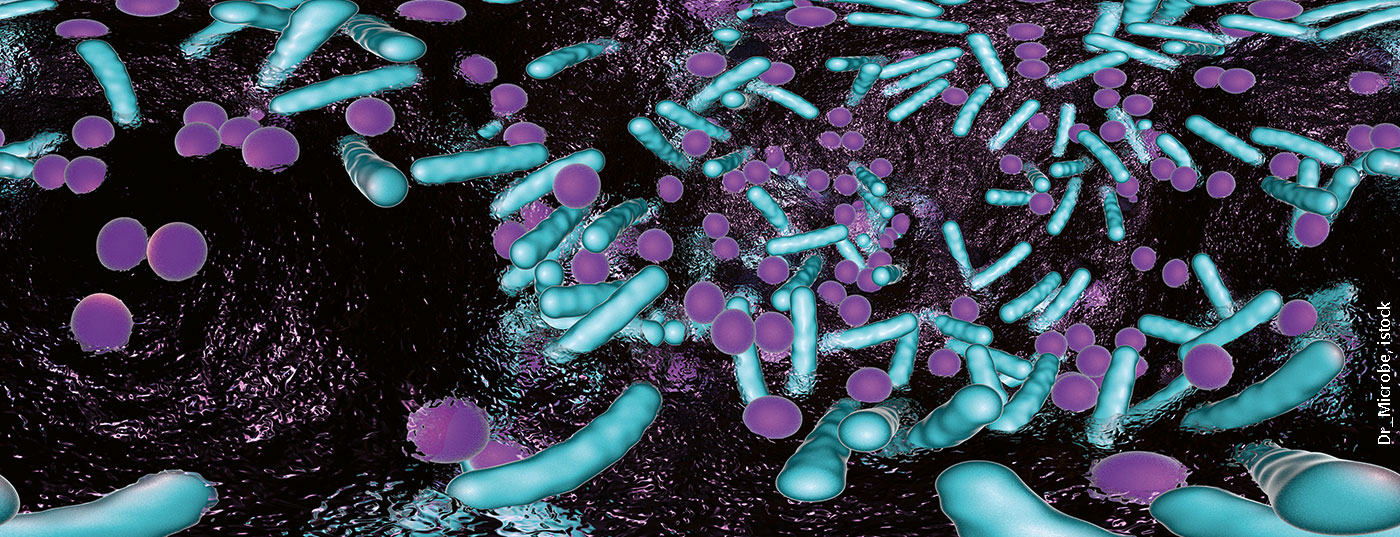An antimicrobial method optimally adapted to the individual wound microenvironment is a success factor in wound treatment. Mechanical debridement is required to completely clear a biofilm, and outpatient care is primarily used to reduce the microbial load. The range of antiseptic wound dressings is huge – what is the new evidence on this?
Careful selection of the appropriate wound care is also important in the local therapy of the wound margin – it is a neuralgic point of the healing process. Antimicrobial substances tend to have an anti-proliferative effect, edema should be taken care of, skin hydration should be ensured and basic care should be provided. Often the wound margin is affected by biofilm, which can be visualized by fluorescence measurement – bacteria have an intrinsic fluorescence and are stained when irradiated with UV light bacterial colonization at a concentration >104/m2.
Biofilm does not equal infection, but the risk is high
A biofilm does not per se cause an infection – it can also affect a wound that does not look infected at all. Prof. Dr. med. Ewa K. Stürmer, Director of the Institute for Translational Wound Research at the University of Witten/Herdecke (D) [1] illustrates this with the case study of a diabetic foot ulcer. “For the removal of biofilm, the best and only therapy of choice at the moment is mechanical removal by curette or scalpel” [1]. This is also the conclusion of current consensus recommendations [2]. In 78% of all cases of chronic wounds, a biofilm develops with potentially negative effects on wound healing [3]. In order to prevent possible infection, it is essential to reduce the germ load by taking suitable measures in the context of outpatient wound care. These include intensive wiping and NaCl, wound irrigation solutions, spray disinfection, antiseptic dressing. However, a complete cleaning of the biofilm is only possible by mechanical debridement, the speaker explains. The wound environment is a key determinant of antimicrobial performance in the context of biofilm therapy, according to one of the current findings in this field [3]. What is a biofilm? It is a structured community of microbes with genetic diversity and variable gene expression that creates behaviors and defenses leading to the generation of unique (chronic) infections with significant tolerance to antibiotics and antimicrobials while protecting against host immunity [1].
Hydrophobic wound net or other wound dressing?
For a locally infected wound, the speaker recommends switching to a hydrophobic wound mesh after 7-10 days of antimicrobial dressings and wound irrigation solutions. The mechanism of action is due, among other things, to its structure, which favorably influences bacterial uptake. “Hydrophobic wound meshes are not only cost-saving but also cell-protective” [1]. According to a recent meta-analysis [4], silver, a substance frequently contained in wound dressings, has antimicrobial effects, improved quality of life and good cost-effectiveness when used in a targeted and time-limited manner. Correct indication and therapy duration over a maximum period of 14 days are crucial [4]. Clinically relevant silver resistance could not be demonstrated [5]. The conclusion of a 2019 article on this is that there is no evidence at this time that silver resistance is a serious health threat [5]. Further studies are needed to make clearer statements on this and to determine the amount of silver required for an optimal therapeutic effect. When silver-containing wound dressings are used in a targeted manner and for a limited period of time (maximum 14 days), current knowledge indicates not only antimicrobial effects but also an improvement in the quality of life and good cost-effectiveness [5].
Smart technologies in wound care
Although the industry already offers products in the field of smart wound technologies, the speaker is skeptical about their practicality. Nevertheless, a lot is happening in this area at the moment and the use of synergies and further development of corresponding products is a forward-looking area. However, the measurement of pH, temperature, hypoxia and other parameters by appropriate devices is only useful if this information can be used as a basis for appropriate measures. The question for which wound, which treatment is indicated and which materials and methods are conducive to the healing process or not, is very complex and takes place on another level, the speaker points out: Should the ph-value be acidic or alkaline? Is hypoxia present? If so, is it relevant? Does the wound need growth factors or enzymes?
|
Translational wound research As demographics change, there are an increasing number of older people with vascular impairments and associated wound healing disorders. Often there is multimorbidity, typical primary diseases are for example diabetes, pAVK, heart failure or immunodeficiency. Exploring the pathophysiology of chronic wounds is the focus of the translational wound research field. The goal is to drive improvement and acceleration of wound healing processes and make them useful for patients. |
Case-specific solutions
Addressing such and other questions is the subject of translational wound research – whose goal is to advance the improvement and acceleration of wound healing processes and make them useful for patients. The pathophysiology of chronic wounds is a focus of this medical research subfield. The methodological spectrum is diverse and includes abdominoplasty as well as 3D models with primary human (skin) cells, adult stem cells of adipose tissue or immunocompetent cells/wound secretions (acute and chronic wounds). One specific subproject is concerned with the development of a patch designed to stop bleeding more quickly after injuries. While this already exists in emergency medicine, he said it is too expensive for everyday use. Wound healing is a complex and multi-layered field, whereby an isolated view often does not lead to the goal. Accordingly, translational wound research takes a holistic approach. There is no patent remedy for a method of wound healing that is effective in all cases. The spectrum of possibilities is diverse and can range from activation of stem cells, further development of wound dressings to the use of phytotherapeutics. Unlike other specialties in medicine, there is a relatively small evidence base in wound research, which should change in the future, the speaker suggests.
Source: Nuremberg Wound Congress
Literature:
- Stürmer EK: Wound colonization, infection, or allergy? How to recognize and treat? Prof. Dr. med. Ewa K. Stürmer, Institute for Translational Wound Research, University of Witten/Herdecke (D), slide presentation, Nuremberg Wound Congress 06.12.2019.
- Hülsbömer LF, Rembe JD, Besser M, Stürmer EK: Quantitative and qualitative evaluation of the anti-biofilm efficacy of modern antimicrobial and antiseptic agents in a new bacterial in vitro biofilm model (hpBIOM). Contribution FV37, Nuremberg Wound Congress, Dec 07, 2019.
- Schultz G, et al: (for the Global Wound Biofilm Expert Panel): Consensus guidelines for the identification and treatment of biofilms in chronic nonhealing wounds. Wound Repair and Regeneration 2017; 25 (5): 744-757.
- Dissemond J, et al: Evidence for silver in wound care – meta-analysis of clinical studies from 2000-2015. J Dtsch Dermatol Ges 2017; 15(5): 524-535.
- Percival SL, Salisbury AM, Chen R: Silver, biofilms and wounds: resistance revisited. Crit Rev Microbiol 2019; 45(2): 223-237.
DERMATOLOGIE PRAXIS 2020; 30(1): 24-26 (published 2/23/20, ahead of print).











